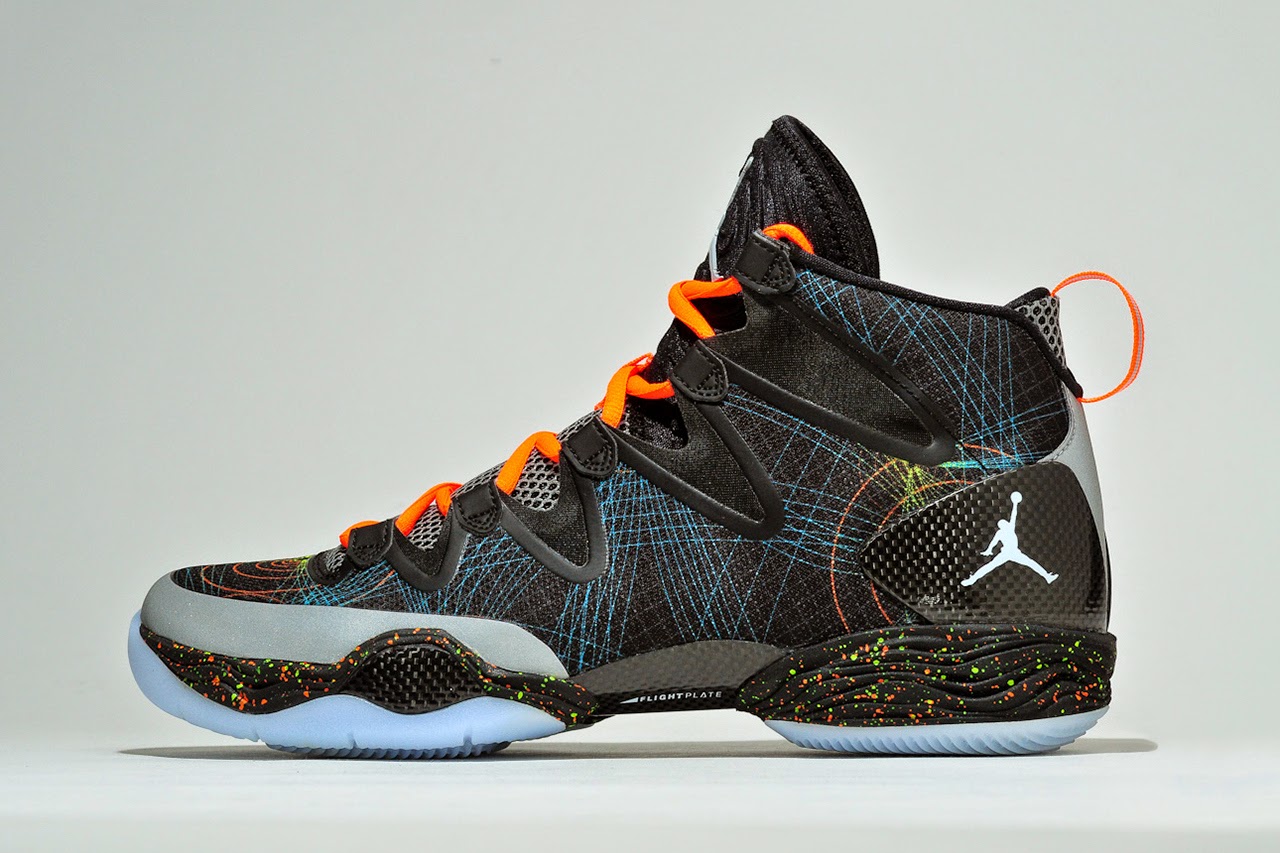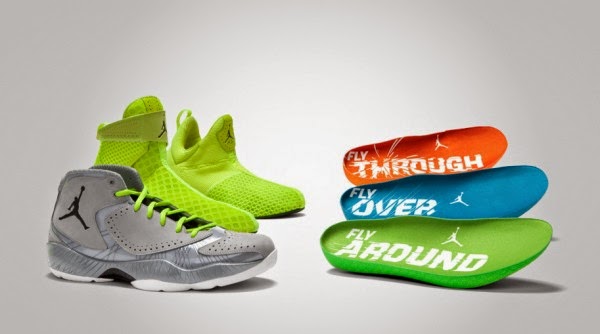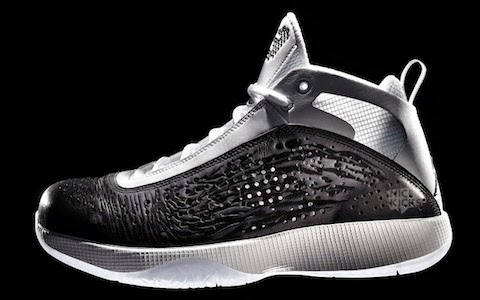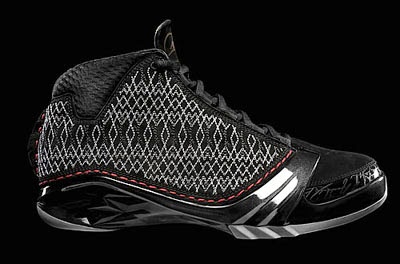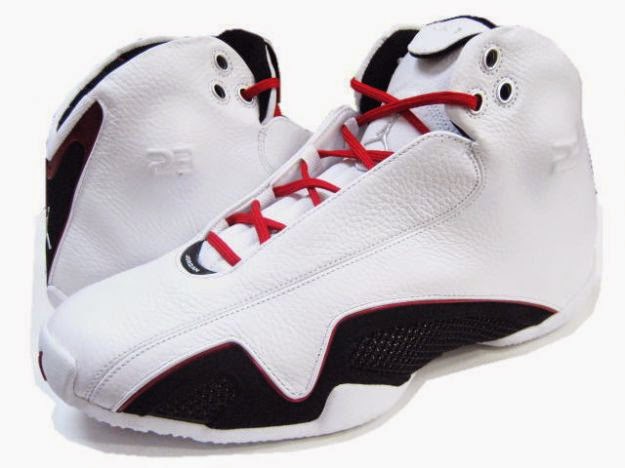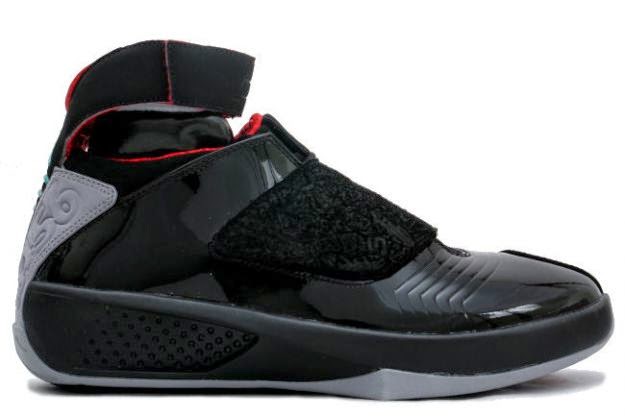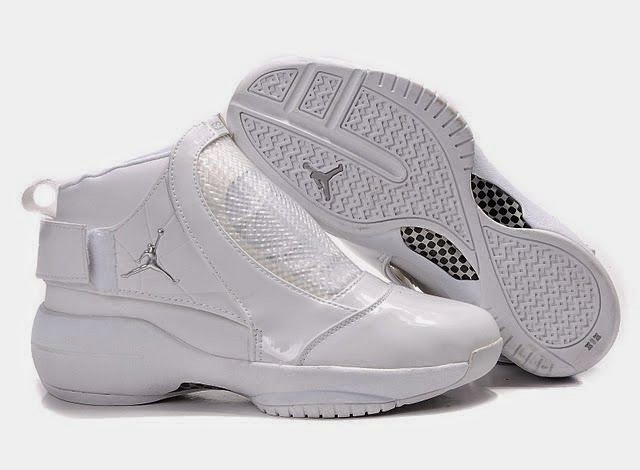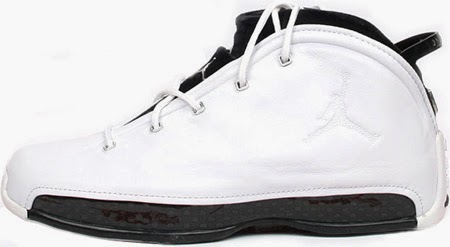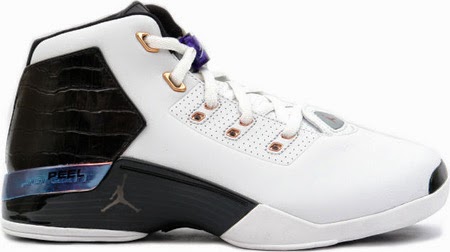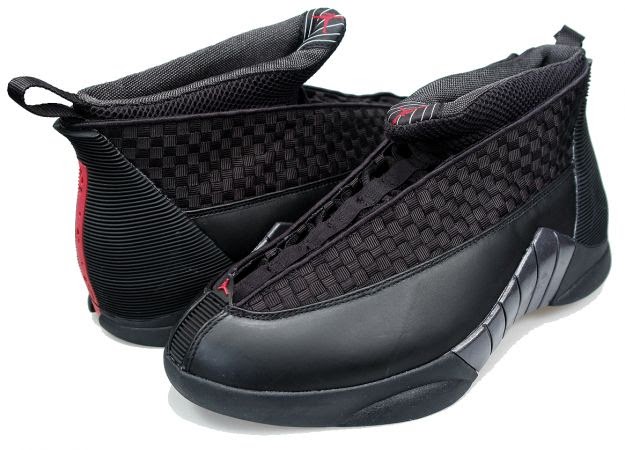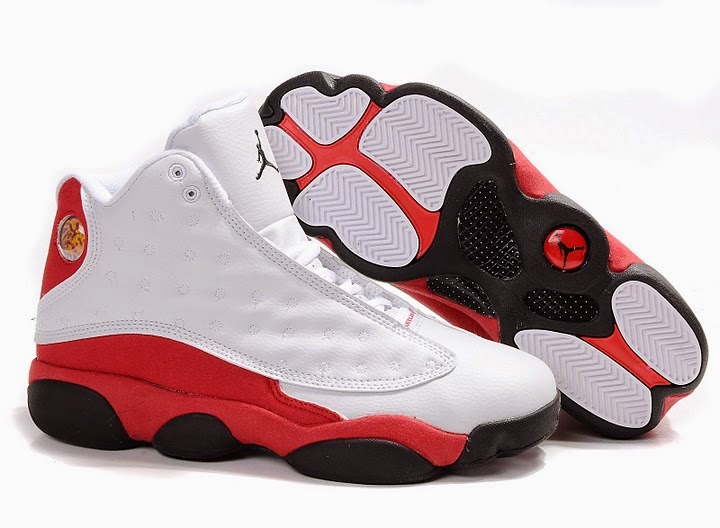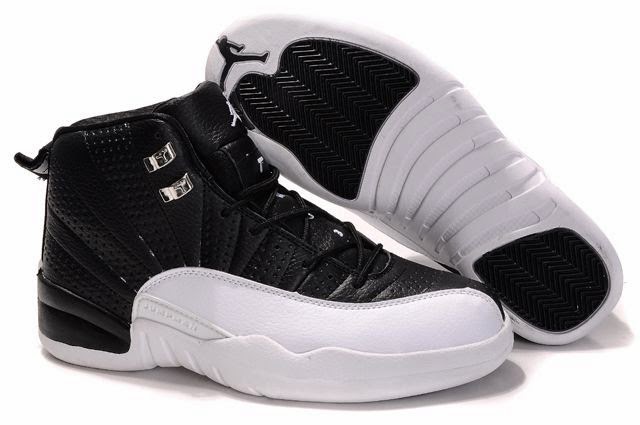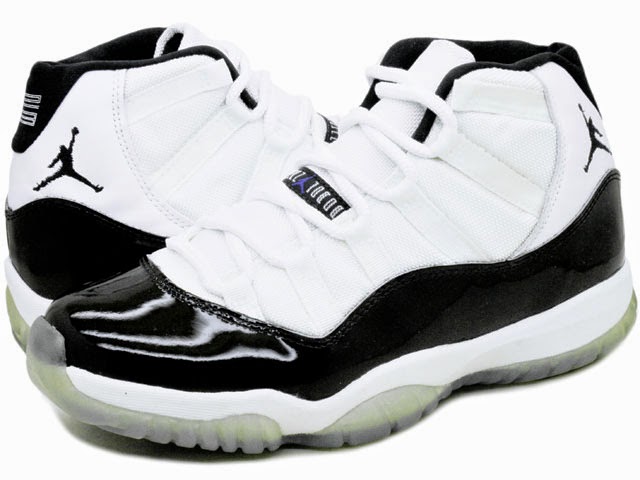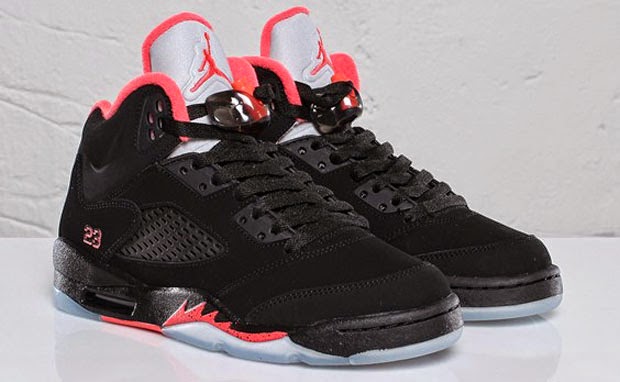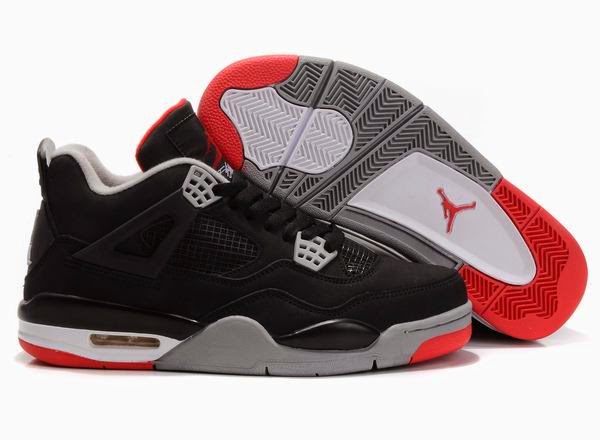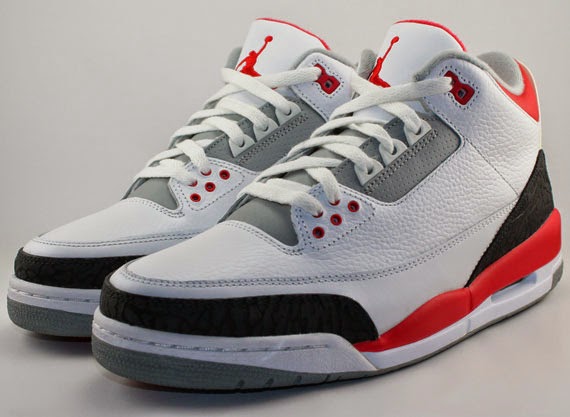Air Jordan is famous brand of shoes and clothing designed, owned, and produced by Michael Jordan for Nike.Here you can find the Air Jordan shoes latest information including Air Jordan 1 to 23.
Tuesday, April 29, 2014
Air Jordan 6 “Carmine” Released Time
There will be some debate regarding this, but the Air Jordan VI “Carmine” Retro, which will be the first time this OG colorway hits store shelves on its own, might be the single best sneaker release of May 2014. This popular colorway was the reason why the 2008 Countdown Package that held this shoe and the odd suede version of the Air Jordan 17 was perhaps among the most popular of the year, and this mid-May drop could reinforce the notion that the Carmines are perhaps one of the best OG Air Jordans of all-time. Check out this latest detailed gallery below, and let us know where the Carmines rank on your personal “all-time” list.
Friday, April 25, 2014
Air Jordan 1 New colorways Gym Red/Sail
Either the all-red shoe trend is currently at its apex, or it peaked in the last few weeks. Whatever the case, I’m pretty certain you can find room in your sneaker rotation for the next “OG” Jordan. The Air Jordan 1 Gym Red/Sail release date, while unconfirmed, seems pretty likely set for June 28, a striking new style on the iconic hoops model-cum-fashion fixture.
The monochromatic red upper sees premium leather overlays set against buttery suede, combining for an impressively conspicuous style. White then enters the picture, minimally used yet striking in its variance, appearing on the Swoosh, branding and midsole.
The monochromatic red upper sees premium leather overlays set against buttery suede, combining for an impressively conspicuous style. White then enters the picture, minimally used yet striking in its variance, appearing on the Swoosh, branding and midsole.
Thursday, April 24, 2014
Air Jordan 1 Mid Nouveau
The Air Jordan 1 Mid Nouveau has always been a classic. Just a slightly different rendition than the original Air Jordan 1 silhouette, the sneaker features a slick combo of black suede and leather throughout. Finishes of dark concord on the inner lining and outsole add depth to the appearance as a white midsole brings everything together. The quality of the design is next to none. Set to release sometime in May, let us know what you think of the Air Jordan 1 Mid Nouveau “Dark Concord.”
Wednesday, April 23, 2014
Air Jordan 2 “Elephant Print” will release on May
The Air Jordan 2 “Elephant Print” will release on May 10th, 2014. The Air Jordan 2 as a whole seems very willing to break from convention during its 2014 run, as we’ve also spotted the “Nightshade” pair that picks up a proprietary Nike print (Safari on that one). Color wise the sneakers wear white, black, and dark concord – but the inclusion of wolf grey keeps them at a distance from any Air Jordan 11s that those first three colors might conjure up. See the “Elephant Print” Jordan 2 after the click and watch for more Air Jordan release info here on Sneaker News.
Tuesday, April 22, 2014
Air Jordan 6 “Speckle”
The Air Jordan 6 in its original form switched back between the leather and Durabuck treatment, and that approach has lived on for the most part – although the Durabuck has slid more and more towards a synthetic suede over the years. For 2014 we’ll see this black and green version pair those two treatments, with leather playing the back half and the black suede creeping in towards the front of the shoes. See the latest set of images for this curious black/green colorway that’s been at times attached to a World Cup theme and stick with Sneaker News for updates on these speckled Jordans.
Monday, April 21, 2014
Air Jordan 29
The Air Jordan XX9 will release in September 2014 for $225.The Air Jordan XX9 carries on Jordan Brand’s tradition of innovation as far as brand new materials and technologies are concerned. Helping us to understand the Brand’s approach to this latest player shoe is Nike designer and Tinker Hatfield protege Tiffany Beers, who is seen here explaining the tailored, intricate nature of the new performance woven upper that was inspired in part by the craftsmanship that the design team encountered on trips to Italy. Continue reading to hear Tiffany talk Air Jordan 29 tech and tell us down in the comments if you’re one of those who is excited to give this shoe a spin for the performance aspects promised.
Saturday, April 19, 2014
Air Jordan 6 “Cigar” released time
Nike SB has been the wing of the Swoosh that’s been the most prone to referencing adult activities with special colorways. Jordan Brand is going there this year though with both the Air Jordan 6 “Champagne” and the Air Jordan 6 “Cigar”, the latter of which is on display here. The exact release date for the sneakers hasn’t been pinned down, but we’d expect them to show up around the time of the 2014 NBA Finals in order to drive home that Championship theme.
Air Jordan 6 Retro White/Sport Blue-Black Released In August
The Year of the Six is upon us — 23rd anniversary of the Air Jordan 6, MJ wore number 23; scads of celebratory releases and all that — and today we get another look at one of the more intriguing options set to drop this fall, the Air Jordan 6 White/Sport Blue.
Intriguing because this is one of the few OG Jordans that has never seen a retro release.
Intriguing because the old Is it called September Blue or Sport Blue? uncertainty added a certain mystique to the shoe. (It’s “Sport Blue,” by the way.)
Intriguing, most of all, because the clean mix of white leather and blue midsole is a perfect look on the iconic model.
Intriguing because this is one of the few OG Jordans that has never seen a retro release.
Intriguing because the old Is it called September Blue or Sport Blue? uncertainty added a certain mystique to the shoe. (It’s “Sport Blue,” by the way.)
Intriguing, most of all, because the clean mix of white leather and blue midsole is a perfect look on the iconic model.
Friday, April 18, 2014
Air Jordan XX9 Black Team Orange Dark Grey
Every year, Jordan Brand takes the launch of its latest flagship model as an opportunity to push the consumer’s expectations and concept of what’s possible. Today the brand officially unveiled the Air Jordan XX9, a shoe that accomplishes those objectives in spades, bringing unrivaled court performance by utilizing two elite technologies — an evolved Jordan Flight Plate and the brand’s first-ever performance-woven upper.
While its inclusion is entirely performance-based, the woven upper was inspired by the fashion of Italy, a country known for its craftsmanship. Embracing that intricate level of detail, the upper’s woven construction is able to forgo the usual four layers and elements of a shoe, instead weaving all into one piece that provides support, structure, interior comfort and exterior abrasion-resistance. The Flight Web system informs the structure and fit of the shoe, as various “panels” differ in stiffness and density to enhance natural motion while still protecting and stabilizing in critical areas. Of course the lack of different layers, adhesives and stitching also ramp up comfort while enhancing breathability in a sock-like fit.
Further, the Flight Web system utilizes webbed straps to wrap the foot and dynamically integrate with the lacing system, locking down the midfoot while allowing the shoe to move naturally with the foot. Articulated padding is then added to the collar, preventing heel-slippage and enhacing the premium feel.
Finally, after debuting to such acclaim on the XX8, the Jordan Flight Plate just had to make a return appearance. The Pebax moderator plate, which maximizes the responsiveness of the Zoom Air units for superlative cushioning, has been redesigned for the Air Jordan XX9, now featuring a tendril — a small bridge of outsole that improves the heel-to-toe transition.
In response to customer demand, the Air Jordan XX9 release date has been shifted back to September, around the start of basketball season, as opposed to the NBA All-Star break launch that the last several flagship models have undergone.
While its inclusion is entirely performance-based, the woven upper was inspired by the fashion of Italy, a country known for its craftsmanship. Embracing that intricate level of detail, the upper’s woven construction is able to forgo the usual four layers and elements of a shoe, instead weaving all into one piece that provides support, structure, interior comfort and exterior abrasion-resistance. The Flight Web system informs the structure and fit of the shoe, as various “panels” differ in stiffness and density to enhance natural motion while still protecting and stabilizing in critical areas. Of course the lack of different layers, adhesives and stitching also ramp up comfort while enhancing breathability in a sock-like fit.
Further, the Flight Web system utilizes webbed straps to wrap the foot and dynamically integrate with the lacing system, locking down the midfoot while allowing the shoe to move naturally with the foot. Articulated padding is then added to the collar, preventing heel-slippage and enhacing the premium feel.
Finally, after debuting to such acclaim on the XX8, the Jordan Flight Plate just had to make a return appearance. The Pebax moderator plate, which maximizes the responsiveness of the Zoom Air units for superlative cushioning, has been redesigned for the Air Jordan XX9, now featuring a tendril — a small bridge of outsole that improves the heel-to-toe transition.
In response to customer demand, the Air Jordan XX9 release date has been shifted back to September, around the start of basketball season, as opposed to the NBA All-Star break launch that the last several flagship models have undergone.
Thursday, April 17, 2014
Air Jordan 3 Newest Retro GS “Wolf Grey”
One of the more celebrated Retro Jordan models is undoubtedly the Air Jordan 3, but this year’s collection of new colorways is a sure test to those who call it the best of all-time. The upcoming “Wolf Grey” colorway, seen here in GS sizes, isn’t too far removed from the original Chicago Bulls make-ups we’re used to seeing, only these are lacking that captive red that give it that character. Still, the clean mix of grey, black, and silver seems too hard to turn away, and once we confirm the release date, we’re certain these will be one of the more chased-after sneakers of the year. Be sure to stay tuned for updated release info on these Jordan shoes, so in the meantime, check out the extra photo below for another look.
Wednesday, April 16, 2014
Nike Skateboarding x Air Jordan 1
Nike Skateboarding x Air Jordan 1 finally came to fruition in March, skate-culture fixture Craig Stecyk collaborating on a special design for the lead shoe in the collection that celebrates the AJ1’s unlikely popularity as a skate shoe thirty years ago. This summer two more Nike SB Air Jordan 1 editions will launch, designed by the legendary Lance Mountain.
It was Mountain who, back in 1987, appeared in a famous skate video that drew all attention to his feet, as he wore a royal blue AJ1 on his left foot and Carolina blue colorway on his right. Embracing the model as a skate shoe embodied the era’s zeitgeist, while the asymmetrical style put an abstract spin on the aesthetics.
Mountain remembered that seminal moment when creating his official Jordan collab. A nod to skaters who mismatch pairs in order to extend the life of each individual shoe, Mountain created a mismatched pair that includes both a black/red and black/royal Jordan. Each is then painted over in either black or white — both colorways will be available — for a uniform look. The wear and tear of each shoe will then erode the exterior paint revealing the colorway beneath in an entirely custom way, unique to each wearer.
Finally, tying his attitude to the design of the shoes, each insole alternates the words “Paint shoes” and “Not walls.”
Quite literally nearly three decades in the making, the Lance Mountain x Nike SB Air Jordan 1 release date is set for June 7. Limited quantities will be carried by select Nike SB accounts and Nike.com.
It was Mountain who, back in 1987, appeared in a famous skate video that drew all attention to his feet, as he wore a royal blue AJ1 on his left foot and Carolina blue colorway on his right. Embracing the model as a skate shoe embodied the era’s zeitgeist, while the asymmetrical style put an abstract spin on the aesthetics.
Mountain remembered that seminal moment when creating his official Jordan collab. A nod to skaters who mismatch pairs in order to extend the life of each individual shoe, Mountain created a mismatched pair that includes both a black/red and black/royal Jordan. Each is then painted over in either black or white — both colorways will be available — for a uniform look. The wear and tear of each shoe will then erode the exterior paint revealing the colorway beneath in an entirely custom way, unique to each wearer.
Finally, tying his attitude to the design of the shoes, each insole alternates the words “Paint shoes” and “Not walls.”
Quite literally nearly three decades in the making, the Lance Mountain x Nike SB Air Jordan 1 release date is set for June 7. Limited quantities will be carried by select Nike SB accounts and Nike.com.
Tuesday, April 15, 2014
Air Jordan 11 Low AQUA SAFARI
Air Jordan 11 Low will be released . Indeed, the Girls’ Air Jordan 11 Low Aqua Safaridrops April 19 as well, and today brings official photos of the eye-catching style.
As the title would indicate, the shoe’s white mesh upper is wrapped with an aqua leather mudguard, itself cover ubiquitously in Safari print texturing. Matching aqua adorns the inner-lining as well which, in concert with the white midsole, gives the shoe an alternating “layered” look.
Finally, a translucent blue outsole adds stylish detail, and volt traction rounds out the look.
Alas, these are limited to girls’ sizing — grade school ($115), pre-school ($70) and toddler ($50) — so best of luck lopping off those toes. Nike.com will stock the shoe Saturday beginning at 8am EDT.
As the title would indicate, the shoe’s white mesh upper is wrapped with an aqua leather mudguard, itself cover ubiquitously in Safari print texturing. Matching aqua adorns the inner-lining as well which, in concert with the white midsole, gives the shoe an alternating “layered” look.
Finally, a translucent blue outsole adds stylish detail, and volt traction rounds out the look.
Alas, these are limited to girls’ sizing — grade school ($115), pre-school ($70) and toddler ($50) — so best of luck lopping off those toes. Nike.com will stock the shoe Saturday beginning at 8am EDT.
Monday, April 14, 2014
Air Jordan 2 Nightshade closed to released?
Call it an educated hunch at the moment, but it certainly seems as if the Air Jordan 2 Nightshade release date is not only set, but imminent. The shoe will hit global Jordan accounts on April 26 and, while unconfirmed, it seems very likely that includes stateside shops.
The fourth AJ2 that now resides on the 2014 launch calendar — with perhaps another on the way — the shoe features navy leather throughout the upper, with Safari print texturing on the collar and toe. Volt sharply juxtaposes the darker profile, appearing on the piping, branding and speckling (laces and midsole), and solid black rounds out the palette on the heel and midsole.
Stay tuned for details as they develop, but go ahead and pencil in 4/26 at the moment.
The fourth AJ2 that now resides on the 2014 launch calendar — with perhaps another on the way — the shoe features navy leather throughout the upper, with Safari print texturing on the collar and toe. Volt sharply juxtaposes the darker profile, appearing on the piping, branding and speckling (laces and midsole), and solid black rounds out the palette on the heel and midsole.
Stay tuned for details as they develop, but go ahead and pencil in 4/26 at the moment.
Saturday, April 12, 2014
Air Jordan 20 Low
The Air Jordan XX was the first milestone model Air Jordan to arrive in this millennium as far as major anniversaries for the line go (Later we got the XX3 and next year we’ll get the three-decades deep 30th version). Taking us back to 2005 is this pair of the Air Jordan 20 created for Mike Bibby, that NBA traveling man who is currently without a home in the league. Continue reading to see how this Air Jordan 20 Low from Bibby’s Kings era gets upgraded with some personal touches and then let us know if they’re worth the price.
Air Jordan XX8
The unveiling of the newest Air Jordan model always has been a big deal. But the AJ XX8 carried that sense of mystery around with it.
The latest installment in the legendary Jordan Brand lineup, designed by Tinker Hatfield and released in February 2013, featured all the cushioning and stability technologies one might expect from Jordan's flagship model. But it all lived behind a shroud, enabling the wearer to decide just how much to reveal.
Several AJs, from the AJ XVI on, featured a shroud or a lace cover of some type. The sock-like shroud of the AJ XX8, comprised of a high-end material from Schoeller textiles in Switzerland, featured a zipper front that folded down neatly to reveal a "2" on the medial (outside) of one shoe and a "3" on the medial of the other (denoting Michael Jordan's iconic jersey number). It offers a blank slate that Jordan Brand has promised to use for a variety of eye-catching colorways during the shoe's life cycle.
The AJ XX8 featured a number of technologies: Zoom Air unit for low-profile cushioning, all-new Jordan Flight Plate, dynamic Fit straps for flexible support, carbon fiber heel counter for support, mesh upper for flexibility and ventilation. The new Jordan Flight Plate that debuted in the midsole of the AJ XX8 was about two years in development. It consisted of a moderator plate, the Zoom Air unit, and rubber.
Designers started with a Nike Shox plate, added air bags, and knew they were getting close. It evolved to consist of a carbon fiber plate designed to deflect force and maximize the Zoom Air and its low-profile responsiveness. This enabled the separation of the forefoot and heel for the first time in the Air Jordan lineage.
For added stability, the AJ XX8 included a molded, carbon-fiber external heel counter that served as a natural extension of the Flight Plate.
The latest installment in the legendary Jordan Brand lineup, designed by Tinker Hatfield and released in February 2013, featured all the cushioning and stability technologies one might expect from Jordan's flagship model. But it all lived behind a shroud, enabling the wearer to decide just how much to reveal.
Several AJs, from the AJ XVI on, featured a shroud or a lace cover of some type. The sock-like shroud of the AJ XX8, comprised of a high-end material from Schoeller textiles in Switzerland, featured a zipper front that folded down neatly to reveal a "2" on the medial (outside) of one shoe and a "3" on the medial of the other (denoting Michael Jordan's iconic jersey number). It offers a blank slate that Jordan Brand has promised to use for a variety of eye-catching colorways during the shoe's life cycle.
The AJ XX8 featured a number of technologies: Zoom Air unit for low-profile cushioning, all-new Jordan Flight Plate, dynamic Fit straps for flexible support, carbon fiber heel counter for support, mesh upper for flexibility and ventilation. The new Jordan Flight Plate that debuted in the midsole of the AJ XX8 was about two years in development. It consisted of a moderator plate, the Zoom Air unit, and rubber.
Designers started with a Nike Shox plate, added air bags, and knew they were getting close. It evolved to consist of a carbon fiber plate designed to deflect force and maximize the Zoom Air and its low-profile responsiveness. This enabled the separation of the forefoot and heel for the first time in the Air Jordan lineage.
For added stability, the AJ XX8 included a molded, carbon-fiber external heel counter that served as a natural extension of the Flight Plate.
Friday, April 11, 2014
Air Jordan 2012
Air Jordan 2011 design veterans Tinker Hatfield and Tom Luedecke joined creative forces once again to create the Air Jordan 2012. The pair drew inspiration from the dancing shoes of the 1920s and '30s, when jazz music was all the rage. The people who danced in these wingtip shoes were considered bold, confident and youthful, just like the AJ 2012.
The Air Jordan 2012 is designed around the idea of "One Shoe, Three Flights." This is a reference to the three different midsole cushioning options that allow ballers to control the game based on their individual playing styles. The "Fly Around" midsole is meant for quick perimeter players who rely on speed and agility to reach the basket. It features forefoot foam and a Zoom Air unit in the heel. The "Fly Over" midsole is for the player that relies on elevation and off-the-ground explosiveness to impact the game. This midsole has a Zoom Air unit in the forefoot and an encapsulated Air Sole unit in the heel for a soft landing. The power player looking to control the inside is offered the "Fly Through" sole, which has a full-length Air Sole unit for an ideal amount of impact protection.
Like the midsole options, the choice of which innersleeve to use depends on your style of play. The low-cut sleeve works well for the quick player seeking a greater range of motion. The high-cut sleeve enhances the overall ankle support, stability and foot protection.
Of course, the AJ 2012 couldn't be a high-performing sneaker without a well-constructed outer shell. Hatfield and Luedecke brought many new performance innovations to the table, which include the debut of a Jordan specific carbon-weave shank plate for superior midfoot stability. The wingtip on the toe-box has tight double stitching and perforations in the shape of an 'M' as a reference to the man, Jordan, himself. Thin lines throughout the midsole give the shoe some extra style while also serving as scratch marks that represent Jordan's "Black Cat" nickname.
The Air Jordan 2012 is designed around the idea of "One Shoe, Three Flights." This is a reference to the three different midsole cushioning options that allow ballers to control the game based on their individual playing styles. The "Fly Around" midsole is meant for quick perimeter players who rely on speed and agility to reach the basket. It features forefoot foam and a Zoom Air unit in the heel. The "Fly Over" midsole is for the player that relies on elevation and off-the-ground explosiveness to impact the game. This midsole has a Zoom Air unit in the forefoot and an encapsulated Air Sole unit in the heel for a soft landing. The power player looking to control the inside is offered the "Fly Through" sole, which has a full-length Air Sole unit for an ideal amount of impact protection.
Like the midsole options, the choice of which innersleeve to use depends on your style of play. The low-cut sleeve works well for the quick player seeking a greater range of motion. The high-cut sleeve enhances the overall ankle support, stability and foot protection.
Of course, the AJ 2012 couldn't be a high-performing sneaker without a well-constructed outer shell. Hatfield and Luedecke brought many new performance innovations to the table, which include the debut of a Jordan specific carbon-weave shank plate for superior midfoot stability. The wingtip on the toe-box has tight double stitching and perforations in the shape of an 'M' as a reference to the man, Jordan, himself. Thin lines throughout the midsole give the shoe some extra style while also serving as scratch marks that represent Jordan's "Black Cat" nickname.
Air Jordan 2011
For the Air Jordan 2011, the Jordan Brand turned to respected design veterans Tinker Hatfield and Tom Luedecke. By being closely involved with the process and having an extremely intelligent, innovative team in place, Michael Jordan has helped maintain the high standards that are expected when it comes to elite Jordan products like the Air Jordan 2011.
There are several unique elements of the Jordan 2011 that highlight the high-quality craftsmanship, such as the fade of color in the leather, which can be hand-buffed for a change in color. In addition, the Jordan 2011 features a distinctive perforated pattern on the upper, a dynamic fit system and two mesh windows for breathability. This attention to detail is what makes the 2011 such an extraordinary product. To top it off, the 2011 features a crazy lacing system - set up like "five little seatbelts" - and a brilliant insole/cushioning system.
There are two cushioning options that come with the Air Jordan 2011. The red insoles are for the explosive player, and feature soft Cushlon foam with a full-length air bag, creating a very responsive option for your feet. The blue insoles are made for the player looking for quickness. The blue alternative, which encompasses compression Phylon, Zoom Air technology in the heel and forefoot, is more about impact-protection. Designer Tom Luedecke said MJ gave the analogy of a warrior choosing his weapon before going into battle when referring to the player picking which insole to use.
Regardless of your style of play, the superiorly crafted Air Jordan 2011 looks good and gives you multiple options to customize your ride on the court.
There are several unique elements of the Jordan 2011 that highlight the high-quality craftsmanship, such as the fade of color in the leather, which can be hand-buffed for a change in color. In addition, the Jordan 2011 features a distinctive perforated pattern on the upper, a dynamic fit system and two mesh windows for breathability. This attention to detail is what makes the 2011 such an extraordinary product. To top it off, the 2011 features a crazy lacing system - set up like "five little seatbelts" - and a brilliant insole/cushioning system.
There are two cushioning options that come with the Air Jordan 2011. The red insoles are for the explosive player, and feature soft Cushlon foam with a full-length air bag, creating a very responsive option for your feet. The blue insoles are made for the player looking for quickness. The blue alternative, which encompasses compression Phylon, Zoom Air technology in the heel and forefoot, is more about impact-protection. Designer Tom Luedecke said MJ gave the analogy of a warrior choosing his weapon before going into battle when referring to the player picking which insole to use.
Regardless of your style of play, the superiorly crafted Air Jordan 2011 looks good and gives you multiple options to customize your ride on the court.
Air Jordan 2010
In 2010, the Air Jordan line turned 25. Coming off the AJ 2009 designed by Jason Mayden, Jordan Brand taps into renowned designers Tinker Hatfield and Mark Smith to craft the 25th Air Jordan.
Continuing the unique style of the Air Jordan line, Hatfield and Smith went with a clear window on the side of the shoe meant to symbolize looking inside of Michael Jordan and his game. The midsole features a uniquely hidden quote from Michael. The asymmetrical collar makes a return to the Air Jordan line with a higher medial side of the collar and the lateral side dropping lower than normal.
The 2010 has a clean toe and features a forefoot that is independent from the rest of the shoe, with a six-row stitch to hold the toe piece together. It features clear TPU in only the essential areas on the shoe. The lightweight Phylon™ midsole is carved out and contoured for the best on-court performance. A full-length Zoom Air™ unit is bottom-loaded inside the outsole of the shoe to disperse shock. That feature is borrowed from running shoes and has never been seen on a basketball shoe until now.
The 2010 is a lightweight, great-fitting shoe that is low to the ground. It's built to feel broken-in on the first wear. It has a thinner Air bag that provides the player with a better ability to feel the floor. The sneaker caters to the modern basketball player who needs to get up and down the court faster and more often. It features a comfortable, glove-like fit assuring the shoe fits snugly against the foot. The protruding outrigger provides excellent lateral stability.
This 25th Air Jordan is another Considered product that avoids using harmful toxins and is constructed using fewer glues, less stitching, less energy, and less waste while utilizing environmentally friendly materials.
As Jordan Brand celebrates their Silver Anniversary, Dwyane Wade is now the face of the brand. The 2010 was launched with Michael Jordan and D-Wade unveiling the shoe to the world in November of '09. The first colorway released on 2/13/10.
Continuing the unique style of the Air Jordan line, Hatfield and Smith went with a clear window on the side of the shoe meant to symbolize looking inside of Michael Jordan and his game. The midsole features a uniquely hidden quote from Michael. The asymmetrical collar makes a return to the Air Jordan line with a higher medial side of the collar and the lateral side dropping lower than normal.
The 2010 has a clean toe and features a forefoot that is independent from the rest of the shoe, with a six-row stitch to hold the toe piece together. It features clear TPU in only the essential areas on the shoe. The lightweight Phylon™ midsole is carved out and contoured for the best on-court performance. A full-length Zoom Air™ unit is bottom-loaded inside the outsole of the shoe to disperse shock. That feature is borrowed from running shoes and has never been seen on a basketball shoe until now.
The 2010 is a lightweight, great-fitting shoe that is low to the ground. It's built to feel broken-in on the first wear. It has a thinner Air bag that provides the player with a better ability to feel the floor. The sneaker caters to the modern basketball player who needs to get up and down the court faster and more often. It features a comfortable, glove-like fit assuring the shoe fits snugly against the foot. The protruding outrigger provides excellent lateral stability.
This 25th Air Jordan is another Considered product that avoids using harmful toxins and is constructed using fewer glues, less stitching, less energy, and less waste while utilizing environmentally friendly materials.
As Jordan Brand celebrates their Silver Anniversary, Dwyane Wade is now the face of the brand. The 2010 was launched with Michael Jordan and D-Wade unveiling the shoe to the world in November of '09. The first colorway released on 2/13/10.
Air Jordan 2009
Following the Air Jordan XX3, Brand Jordan continued the iconic Air series but transitioned away from the numbered system. After the XX3, the Air Jordan game shoe was named after the year it was released. Senior Footwear Designer Jason Mayden was given the task of designing the Air Jordan 2009. Focusing on MJ's defensive game, Mayden drew inspiration from the sport of fencing where skill, strategy and athleticism are key to success. The design is influenced by the Air Jordan I and the use of panache leather goes back to the style of the Air Jordan XI. The 2009 was the second Air Jordan created using the Nike Considered process, which focuses on utilizing low waste, water-based solvent materials that don't harm the environment.
The upper has a sleek pleated satin material for increased durability, greater ventilation and lockdown fit. The lightweight design contours the foot for maximum responsiveness and support.
The AJ 2009 has a Phylon midsole for impact absorption and forefoot Zoom Air to for cushioning. The TPU chassis (inspired by glass sculpture) is different on every shoe, making each pair unique. The carbon fiber arch plate assists midfoot support and performance.
As with the XX3, Articulated Propulsion Technology cushioning allows for quick lateral movement on the court. The herringbone outsole features grooves that naturally flex, making for excellent multi-directional traction.
The 2009 originally launched in two colorways, White/Black/Grey and Black/Varsity Red. It was then released in the Black/Metallic Gold S23 colorway, which was limited to 2,009 pairs. Later in 2009, the Black/Varsity Red/White/Metallic Gold Hall of Fame colorway was released to commemorate MJ's induction.
At the 2009 NBA All-Star game, Joe Johnson, Chris Paul and Ray Allen of Team Jordan wore the Air Jordan 2009 PE. Chris Paul wore the White/Red colorway while Johnson and Allen wore White/Navy versions.
The AJ 2009 has a Phylon midsole for impact absorption and forefoot Zoom Air to for cushioning. The TPU chassis (inspired by glass sculpture) is different on every shoe, making each pair unique. The carbon fiber arch plate assists midfoot support and performance.
As with the XX3, Articulated Propulsion Technology cushioning allows for quick lateral movement on the court. The herringbone outsole features grooves that naturally flex, making for excellent multi-directional traction.
The 2009 originally launched in two colorways, White/Black/Grey and Black/Varsity Red. It was then released in the Black/Metallic Gold S23 colorway, which was limited to 2,009 pairs. Later in 2009, the Black/Varsity Red/White/Metallic Gold Hall of Fame colorway was released to commemorate MJ's induction.
At the 2009 NBA All-Star game, Joe Johnson, Chris Paul and Ray Allen of Team Jordan wore the Air Jordan 2009 PE. Chris Paul wore the White/Red colorway while Johnson and Allen wore White/Navy versions.
Thursday, April 10, 2014
Air Jordan 23
Michael Jordan made 23 one of the most famous numbers in sports history, and it made sense that the Air Jordan XX3 was the most anticipated sneaker in footwear history. Tinker Hatfield returned to lead the design, and his take included new technology and craftsmanship to deliver a timeless addition to the Air Jordan line.
The XX3 was the first basketball shoe to incorporate the Nike Considered construction system, which reduced waste and used environmentally friendly materials without affecting the performance of the shoe. MJ's initials are stitched on each colorway's upper. The XX3 features a hand-stitched upper, articulated chassis, full-length quilted bootie, carbon fiber shank plate and reinforced quarter panels.
The XX3 has the lowest profile midsole of any of the Air Jordans. Cushioning is supplied by Zoom Air and tuned IPS pillars. The tongues of each shoes feature two different logos: the left shoe has a Jumpman and the right shoe has the "23" logo. The outsole was modeled after MJ's thumbprint. The print is also seen on the inside of the tongue to represent the impact and identity of Michael Jordan. MJ's signature was also included on the toe box.
To create buzz around the Air Jordan XX3, 23 pairs of the Titanium model were released at the top 23 locations in the United States, retailing for $230. An All-Star colorway was released in February of 2008 and other colorways including the White/Red, Grey/White/Black/Gold and Stealth were released shortly after. A series of three more versions were produced to commemorate Jordan's three teams: Black/University Blue/White for UNC, Black/Red/White for the Bulls and Black/Royal/White for the Wizards. After the general releases, 23 pairs of a black/red XX3 were released at the top 23 locations just like the Titanium launch.
The XX3 could be seen on many NBA players throughout the season. Chris Paul, Ray Allen and Carmelo Anthony wore the Air Jordan XX3 in the NBA All-Star game. The Air Jordan XX3 was the last numbered Air Jordan shoe in the series. Future Air Jordans would be named for the year it was created.
The XX3 was the first basketball shoe to incorporate the Nike Considered construction system, which reduced waste and used environmentally friendly materials without affecting the performance of the shoe. MJ's initials are stitched on each colorway's upper. The XX3 features a hand-stitched upper, articulated chassis, full-length quilted bootie, carbon fiber shank plate and reinforced quarter panels.
The XX3 has the lowest profile midsole of any of the Air Jordans. Cushioning is supplied by Zoom Air and tuned IPS pillars. The tongues of each shoes feature two different logos: the left shoe has a Jumpman and the right shoe has the "23" logo. The outsole was modeled after MJ's thumbprint. The print is also seen on the inside of the tongue to represent the impact and identity of Michael Jordan. MJ's signature was also included on the toe box.
To create buzz around the Air Jordan XX3, 23 pairs of the Titanium model were released at the top 23 locations in the United States, retailing for $230. An All-Star colorway was released in February of 2008 and other colorways including the White/Red, Grey/White/Black/Gold and Stealth were released shortly after. A series of three more versions were produced to commemorate Jordan's three teams: Black/University Blue/White for UNC, Black/Red/White for the Bulls and Black/Royal/White for the Wizards. After the general releases, 23 pairs of a black/red XX3 were released at the top 23 locations just like the Titanium launch.
The XX3 could be seen on many NBA players throughout the season. Chris Paul, Ray Allen and Carmelo Anthony wore the Air Jordan XX3 in the NBA All-Star game. The Air Jordan XX3 was the last numbered Air Jordan shoe in the series. Future Air Jordans would be named for the year it was created.
Air Jordan 22
The super advanced F-22 Raptor fighter jet served as the inspiration for the D'Wayne Edwards as he set about designing the Air Jordan XX2. The sharp lines of the XX2's upper were patterned after the sharp maneuverability of the F-22, and the shoe's efficient sculpted design and a stable extended heel counter made it lightweight and supportive, similar to the fighter jet.
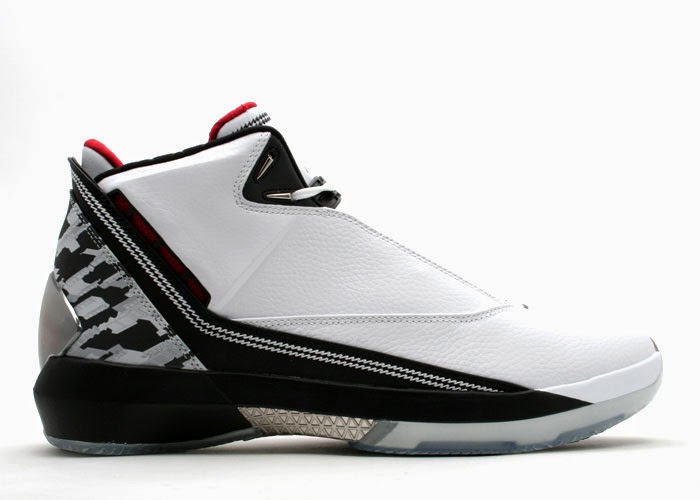
The Air Jordan XX2 featured a triangular quilted pattern on the collar and a seamless bootie that maximized comfort and breathability. The Air Jordan XX2 featured zigzag stitching inspired by the jet. The first titanium-coated shank plate was built into the XX2, as were titanium lace loops/lace locks. Invisible Independent Podular Suspension system, updated from the previous Air Jordan cushioning system, offered responsive double-stacked Zoom Air or shock-absorbing encapsulated Air. A fresh chevron pattern was introduced to the outsole to provide improved traction.
The Air Jordan XX2 was released during the 2007 All-Star weekend on Michael Jordan's 44th birthday, Feb. 17. Fifteen different colorways of the XX2 were issued, including a special edition made out of basketball leather. Colors representing Atlanta, Dallas, Denver, Detroit and Seattle were also created.
Throughout the 2007-2008 season the Air Jordan XX2 was worn by Joe Johnson, Josh Howard, Carmelo Anthony, Richard Hamilton and Ray Allen. At the 2007 All-Star game in Las Vegas, Rip Hamilton and Ray Allen wore Player Exclusive Air Jordan XX2.

The Air Jordan XX2 featured a triangular quilted pattern on the collar and a seamless bootie that maximized comfort and breathability. The Air Jordan XX2 featured zigzag stitching inspired by the jet. The first titanium-coated shank plate was built into the XX2, as were titanium lace loops/lace locks. Invisible Independent Podular Suspension system, updated from the previous Air Jordan cushioning system, offered responsive double-stacked Zoom Air or shock-absorbing encapsulated Air. A fresh chevron pattern was introduced to the outsole to provide improved traction.
The Air Jordan XX2 was released during the 2007 All-Star weekend on Michael Jordan's 44th birthday, Feb. 17. Fifteen different colorways of the XX2 were issued, including a special edition made out of basketball leather. Colors representing Atlanta, Dallas, Denver, Detroit and Seattle were also created.
Throughout the 2007-2008 season the Air Jordan XX2 was worn by Joe Johnson, Josh Howard, Carmelo Anthony, Richard Hamilton and Ray Allen. At the 2007 All-Star game in Las Vegas, Rip Hamilton and Ray Allen wore Player Exclusive Air Jordan XX2.
Air Jordan 21
D'Wayne Edwards, the lead designer on the Air Jordan XX1, drew inspiration from a Bentley Continental GT coupe to combine style and substance in this version of the Air Jordan.
The XX1 featured a seamless diamond quilted bootie, super-clean upper and a lower foot air grille. The double-lasted Phylon midsole provided a low profile feel and a carbon fiber shank plate allowed for maximum midfoot and arch support. Possibly the most innovative component of the AJ XX1 was the evolution of the Independent Podular Suspension technology the wearer of the XX1 could choose between Zoom Air or encapsulated Air cushioning in the heel.
Two original colorways of the Air Jordan XX1 released in 2006. The White/Red model was made of full grain leather while the Red/Black was constructed of rich suede. Two low versions were also released in white and in black.
The commercial for the Air Jordan XX1 featured young athletes reenacting famous moments from Michael's career, including the shot on Craig Ehlo, recreations from the Slam Dunk contests, the "last shot," and the infamous "Michael shrug." The tagline of the commercial was "Let your game speak."
The XX1 featured a seamless diamond quilted bootie, super-clean upper and a lower foot air grille. The double-lasted Phylon midsole provided a low profile feel and a carbon fiber shank plate allowed for maximum midfoot and arch support. Possibly the most innovative component of the AJ XX1 was the evolution of the Independent Podular Suspension technology the wearer of the XX1 could choose between Zoom Air or encapsulated Air cushioning in the heel.
Two original colorways of the Air Jordan XX1 released in 2006. The White/Red model was made of full grain leather while the Red/Black was constructed of rich suede. Two low versions were also released in white and in black.
The commercial for the Air Jordan XX1 featured young athletes reenacting famous moments from Michael's career, including the shot on Craig Ehlo, recreations from the Slam Dunk contests, the "last shot," and the infamous "Michael shrug." The tagline of the commercial was "Let your game speak."
Air Jordan 20
To commemorate 20 years of the Air Jordan, in 2005 legendary designer Tinker Hatfield returned to work on the Air Jordan XX. Hatfield drew inspiration from several sources in Jordan's life, including his love of motor sports.
The Air Jordan XX featured a breathable sphere lining, an integrated midfoot support strap, a floating ankle leash and an internalized impact distribution plate. The hidden lacing system and midfoot strap offered a lockdown performance fit. Independent Podular Suspension, a free-moving targeted cushioning technology, was introduced in the Air Jordan XX.
On the back heel of the Air Jordan XX the numbers 85 and 05, which signified the year the Air Jordan line was introduced and the year the XX released. The outsole of the Air Jordan XX displayed 20 herringbone pods that displayed the heritage of the Air Jordan franchise. Perhaps the most interesting highlight of the AJ XX was the laser-etched logo treatment on the strap of the XX. Created by Mark Smith, this design paid homage to Jordan's life.
The Air Jordan XX released in three original colorways: White/Red/Black, Black/Black/Red and White/Black/Red. Three regional colorways were also released: Chutney/White/Black, Red/White/Black and University Blue/White/Black. An Air Jordan XX low and a ¾ were also released in 2005.
Multiple NBA players wore the Air Jordan XX during the 2004-2005 season, including Ray Allen and Carmelo Anthony.
The Air Jordan XX featured a breathable sphere lining, an integrated midfoot support strap, a floating ankle leash and an internalized impact distribution plate. The hidden lacing system and midfoot strap offered a lockdown performance fit. Independent Podular Suspension, a free-moving targeted cushioning technology, was introduced in the Air Jordan XX.
On the back heel of the Air Jordan XX the numbers 85 and 05, which signified the year the Air Jordan line was introduced and the year the XX released. The outsole of the Air Jordan XX displayed 20 herringbone pods that displayed the heritage of the Air Jordan franchise. Perhaps the most interesting highlight of the AJ XX was the laser-etched logo treatment on the strap of the XX. Created by Mark Smith, this design paid homage to Jordan's life.
The Air Jordan XX released in three original colorways: White/Red/Black, Black/Black/Red and White/Black/Red. Three regional colorways were also released: Chutney/White/Black, Red/White/Black and University Blue/White/Black. An Air Jordan XX low and a ¾ were also released in 2005.
Multiple NBA players wore the Air Jordan XX during the 2004-2005 season, including Ray Allen and Carmelo Anthony.
Wednesday, April 9, 2014
Air Jordan 19
Senior Designer Tate Kuerbis headed the Air Jordan XIX design with support from Jason Mayden, Wilson Smith III, Josh Heard and Suzette Henri. Using the deadly black mamba as a design source, the AJ XIX featured lightweight, supportive Tech Flex material on the upper to create the lightest, most breathable Air Jordan to date. Tech Flex made the Air Jordan XIX flexible without sacrificing support or comfort.
The AJ XIX featured a carbon fiber shank plate, Phylon midsole, patent leather toe box, a Velcro heel strap and plastic lace-locks. A double-stacked heel and full-length Zoom Air ensured maximum cushioning.
The Air Jordan XIX's unique box opened from the middle and each shoe came in a netted bag. Five colors of the original Air Jordan XIX included the Black/Red, White/White/Grey, White/Black, White/Red and White/Navy. Four Air Jordan XIX SE colorways were released, as were four low-top models.
NBA players including Carmelo Anthony, Gary Payton, Jason Kidd, Michael Finley, Mike Bibby, Ray Allen and Richard Hamilton wore the Air Jordan XIX.
The AJ XIX featured a carbon fiber shank plate, Phylon midsole, patent leather toe box, a Velcro heel strap and plastic lace-locks. A double-stacked heel and full-length Zoom Air ensured maximum cushioning.
The Air Jordan XIX's unique box opened from the middle and each shoe came in a netted bag. Five colors of the original Air Jordan XIX included the Black/Red, White/White/Grey, White/Black, White/Red and White/Navy. Four Air Jordan XIX SE colorways were released, as were four low-top models.
NBA players including Carmelo Anthony, Gary Payton, Jason Kidd, Michael Finley, Mike Bibby, Ray Allen and Richard Hamilton wore the Air Jordan XIX.
Air Jordan 18
Senior Footwear Designer Tate Kuerbis was named as the designer of the Air Jordan XVIII. Most of the inspiration for the XVIII design came from the high-end automobiles: sleek racing lines, F1 race cars and race car driving shoes. Fine Italian dress shoes also inspired the stitching on the Air Jordan XVIII outsole.
The AJ XVIII featured a one-piece leather upper, a carbon fiber comfort control plate incorporated into the insole, a hand-stitched outsole, dual-layer heel and forefoot Zoom Air cushioning. The Air Jordan XVII was released in a pull-out box with a cut-out "18" on the lid. It included a brush for the black suede colorway, a towel for cleaning and the Air Jordan XVIII Driver's Manual booklet. Jordan Brand did a "Love" campaign surrounding the release of the AJ XVIII, celebrating MJ's career and final year in the NBA.
Three colors of the Air Jordan XVIII were released in 2003. The Black/Royal model was made of suede, while the White/Royal and White/Red versions were made of leather. Two low versions were released in Black/Black and White/University blue. Along with the mids and lows, Brand Jordan released the Air Jordan 18.5 the primary difference in design was a perforated Jumpman logo on the side of the upper.
In 2002-2003, Michael Jordan was selected to his 14th and final NBA All-Star Game. During his final season, he wore the Air Jordan XVIII. Other NBA players wearing the shoe included Richard Hamilton, Scottie Pippen, Ray Allen, Mike Bibby, Michael Finley and Carmelo Anthony.
MJ's final NBA game was April 16, 2003, against the Philadelphia 76ers. He wore the White/Royal Air Jordan XVIII.
The AJ XVIII featured a one-piece leather upper, a carbon fiber comfort control plate incorporated into the insole, a hand-stitched outsole, dual-layer heel and forefoot Zoom Air cushioning. The Air Jordan XVII was released in a pull-out box with a cut-out "18" on the lid. It included a brush for the black suede colorway, a towel for cleaning and the Air Jordan XVIII Driver's Manual booklet. Jordan Brand did a "Love" campaign surrounding the release of the AJ XVIII, celebrating MJ's career and final year in the NBA.
Three colors of the Air Jordan XVIII were released in 2003. The Black/Royal model was made of suede, while the White/Royal and White/Red versions were made of leather. Two low versions were released in Black/Black and White/University blue. Along with the mids and lows, Brand Jordan released the Air Jordan 18.5 the primary difference in design was a perforated Jumpman logo on the side of the upper.
In 2002-2003, Michael Jordan was selected to his 14th and final NBA All-Star Game. During his final season, he wore the Air Jordan XVIII. Other NBA players wearing the shoe included Richard Hamilton, Scottie Pippen, Ray Allen, Mike Bibby, Michael Finley and Carmelo Anthony.
MJ's final NBA game was April 16, 2003, against the Philadelphia 76ers. He wore the White/Royal Air Jordan XVIII.
Air Jordan 17
When Michael Jordan resigned as Washington Wizards president of basketball operations and returned to the court, he wore the Air Jordan XVII. Wilson Smith III again led the design of the Air Jordan XVII.
Smith had a couple of inspirations for this shoe. About the time sketching for the AJ XVII started, musician Michael Phillips was signed by Brand Jordan. Smith adopted the smooth lines and flow of a jazz solo as the theme of the AJ XVII. Smith also incorporated the fine details of an Aston Martin car and the outsole design was said to have come from a golf course Michael played.
Smith had a couple of inspirations for this shoe. About the time sketching for the AJ XVII started, musician Michael Phillips was signed by Brand Jordan. Smith adopted the smooth lines and flow of a jazz solo as the theme of the AJ XVII. Smith also incorporated the fine details of an Aston Martin car and the outsole design was said to have come from a golf course Michael played.
The XVII featured a TPU heel stabilizer, heel and forefoot Tuned Air (a first for the Jordan line), a dynamic-fit sleeve, hidden quick lace system, lace-locks, a full-length composite shank plate and variable-width lacing for a more snug fit. Among Smith's innovations was the inclusion of a removable midfoot cover, which allowed the wearer to choose whether the laces would be visible. A CD-Rom and metal briefcase were also included to make the Air Jordan XVII the most expensive Air Jordan ever produced at the time, with a suggested retail price of $200.
The Air Jordan XVII had multiple versions. Three mid colors were released: white/blue, black/black and white/red. An Air Jordan XVII version featured metallic copper and faux alligator leather on the heel. Three low models were released, including a white/lightning All-Star version. To top off the AJ XVII run, three colorways of super low mule slip-ons were released.
In Jordan's first year back with the Wizards, he averaged nearly 23 points per game. In January 2002, he scored his 30,000th point against the Chicago Bulls while wearing the Air Jordan XVII. At his 13th All-Star Game, he wore the Air Jordan XVII Low in the white/lightning color.
During the 2001-2002 season, the XVII was worn by players including Kobe Bryant, Mike Bibby, Michael Finley and Eddie Jones.
The Air Jordan XVII had multiple versions. Three mid colors were released: white/blue, black/black and white/red. An Air Jordan XVII version featured metallic copper and faux alligator leather on the heel. Three low models were released, including a white/lightning All-Star version. To top off the AJ XVII run, three colorways of super low mule slip-ons were released.
In Jordan's first year back with the Wizards, he averaged nearly 23 points per game. In January 2002, he scored his 30,000th point against the Chicago Bulls while wearing the Air Jordan XVII. At his 13th All-Star Game, he wore the Air Jordan XVII Low in the white/lightning color.
During the 2001-2002 season, the XVII was worn by players including Kobe Bryant, Mike Bibby, Michael Finley and Eddie Jones.
Air Jordan 16
Smith took inspiration from marching boots, high-performance automobiles and architecture. The upper of the Air Jordan XVI was built with lightweight mesh and included a full-length inner booty. The shoe had a patent leather toe rand. The full-grain leather and breathable mesh upper could be covered by a unique removable shroud that allowed the Air Jordan XVI to transition from an off-court shoe into a game shoe. The shroud featured a magnetic fastening cover for added lockdown.
The square toe box was very roomy compared to previous Air Jordans, and the patent leather toe of the XVI was taken from the AJ XI. The shoe featured a return to the visible Air-Sole cushioning and the translucent outsole that was featured on Air Jordans V, VI and XI. The Air Jordan XVI introduced blow-molded heel and forefoot Zoom Air to the line as the Air Jordan progressed toward performance basketball.
Four colorways of the Air Jordan XVI were released in 2001. The Black/Red and White/Navy versions featured patent leather toes and the wheat model had a rich suede upper. The Cherrywood color was constructed of full-grain leather. Two low versions were released as well: white/red and black/black.
The Air Jordan XVI could be seen on Michael Finley, Mike Bibby, Quentin Richardson, Darius Miles and Reggie Miller during the season. Considered to be one of the most stylish off-court Air Jordans, the XVI was worn by Michael in a suit back in 2001 Brand Jordan ads.
The square toe box was very roomy compared to previous Air Jordans, and the patent leather toe of the XVI was taken from the AJ XI. The shoe featured a return to the visible Air-Sole cushioning and the translucent outsole that was featured on Air Jordans V, VI and XI. The Air Jordan XVI introduced blow-molded heel and forefoot Zoom Air to the line as the Air Jordan progressed toward performance basketball.
Four colorways of the Air Jordan XVI were released in 2001. The Black/Red and White/Navy versions featured patent leather toes and the wheat model had a rich suede upper. The Cherrywood color was constructed of full-grain leather. Two low versions were released as well: white/red and black/black.
The Air Jordan XVI could be seen on Michael Finley, Mike Bibby, Quentin Richardson, Darius Miles and Reggie Miller during the season. Considered to be one of the most stylish off-court Air Jordans, the XVI was worn by Michael in a suit back in 2001 Brand Jordan ads.
Air Jordan 15
Michael Jordan announced his retirement after the 1998 season, and designer Tinker Hatfield was once again challenged to design a shoe that MJ would never wear on the court. Hatfield found inspiration in the X-15 fighter plane from the 1950s, which at the time set numerous speed records.
The AJ XV had an aggressive, sharp-edged and unusual shape. It was built with a woven Kevlar material, had a fully molded Pebax reinforced heel counter, incorporated a large mesh tongue that stuck out (almost mimicking Michael). The heel counter featured numbers which significant to MJ's career 23.6.15, representing Michael's jersey number, the number of titles he won, and the model of Air Jordan. The heel counter extended to the outsole and read 2.17 Jordan's birthday.
The XV featured a hidden speed lacing system, seamless dynamic-fit sleeve, rubber herringbone traction pods, an injected TPR external heel counter and a breathable leather pattern. The XV also featured a full Zoom Air-Sole for cushioning.
The Air Jordan XV was released in a total of four colorways in 1999-2000. The XV was also released in player exclusive colors including White/Green, White/Carolina Blue, White/Red and White/Purple. Several Team Jordan athletes sported the Air Jordan XV. Mike Bibby, Michael Finley, Ray Allen, Derek Anderson and Reggie Miller all wore variations of the X-15 inspired kicks.
Air Jordan 14
Nike designers Tinker Hatfield and Mark Smith teamed up once again for the Air Jordan XIV worn by Michael during the 1998 Finals, it was the last shoe he wore as a Chicago Bull.
Jordan hit the infamous "last shot" against the Utah Jazz while wearing the Black-Red colorway. Seven years later, many Brand Jordan athletes wore the Retro version of the XIV on the court when shoes were hitting at retail. The idea for the XIV was modeled after Michael's love for cars, inspired specifically from a Ferrari. The Air Jordan XIV boasted a Ferrari-like shield featuring a Jumpman logo. In fact, the design of the AJ XIV included seven Jumpman logos on each shoe for a total of 14 per pair. The Jumpman logo can be seen on the side heel, outsole, insole, back heel, toe and on the metal lace tips.
The asymmetrical collar provided support, while mesh vents made for a breathable cooling system. Low-profile heel and forefoot Zoom Air made the Air Jordan XIV a comfortable ride, and many athletes consider the AJ XIV one of the best performance basketball shoes of all time.
The XIV was originally released in five mids and three low tops in 1998 and 1999. It was re-released in 2005 and 2006 in 10 total colorways. The popular "Last Shot" XIVs were brought back along with a variation of the White/Red colorway. One of the most sought-after AJ XIV models, the Indiglos, have yet to be re-released by Brand Jordan.
Jordan hit the infamous "last shot" against the Utah Jazz while wearing the Black-Red colorway. Seven years later, many Brand Jordan athletes wore the Retro version of the XIV on the court when shoes were hitting at retail. The idea for the XIV was modeled after Michael's love for cars, inspired specifically from a Ferrari. The Air Jordan XIV boasted a Ferrari-like shield featuring a Jumpman logo. In fact, the design of the AJ XIV included seven Jumpman logos on each shoe for a total of 14 per pair. The Jumpman logo can be seen on the side heel, outsole, insole, back heel, toe and on the metal lace tips.
The asymmetrical collar provided support, while mesh vents made for a breathable cooling system. Low-profile heel and forefoot Zoom Air made the Air Jordan XIV a comfortable ride, and many athletes consider the AJ XIV one of the best performance basketball shoes of all time.
The XIV was originally released in five mids and three low tops in 1998 and 1999. It was re-released in 2005 and 2006 in 10 total colorways. The popular "Last Shot" XIVs were brought back along with a variation of the White/Red colorway. One of the most sought-after AJ XIV models, the Indiglos, have yet to be re-released by Brand Jordan.
Tuesday, April 8, 2014
Air Jordan 13
For the 1997-1998 season, designer Tinker Hatfield inspired by Michael's cat-like play drew up the AJ XIII. (He didn't realize Michael's friends had already nicknamed him "The Black Cat.")
The hologram on the upper resembled the eye of a panther and the outsole had a paw-like design. The XIII featured heel and forefoot Zoom Air, a Phylon midsole and podular tooling, making it one of the most comfortable Air Jordans in the series. A carbon fiber midfoot shank and asymmetrical collar were also featured on the XIII.
The Air Jordan XIII was originally released in five mid colorways and two low colors. Jordan wore the AJ XIII throughout the 1997-1998 season and into the playoffs (until he introduced the AJ XIV in the 1998 NBA Finals against the Jazz). Michael wore the white-based colorways of the XIII at home and the black-based versions on the road throughout the season.
The AJ XIII was brought back in 10 colorways in 2004 and 2005. The season MJ wore the AJ XIII, he was voted to his 12th All-Star game (he was again the MVP), won his record-setting 10th straight league scoring title and was named first team All-NBA and first team All-Defense. The Bulls beat the Jazz to win their third consecutive title, giving MJ his sixth NBA Championship and sixth NBA Finals MVP award.
Air Jordan 12
Tinker Hatfield and Michael Jordan collaborated to create the durable, stylish Air Jordan XII as a follow-up to the Air Jordan XI.
Inspired by a women's fashion shoe and the Japanese flag, the Air Jordan XII was clean and simple. The rich leather upper was stitched to resemble a rising sun, while the toe and accent overlays were made of faux reptile leather. The XII featured the slogan "TWO 3" down the tongue, metal lace loops with Jumpman logos and a pull tab that ran up the entire heel that read, "QUALITY INSPIRED BY THE GREATEST PLAYER EVER."
The XII had a full-length carbon fiber shank like the AJ XI. The XII introduced full-length Zoom Air cushioning to the Jordan line.
The Air Jordan XII was originally released in five colorways, including the black/red version that MJ wore during Game 5 of the 1997 NBA Finals against the Utah Jazz. In that game, Michael was ill and his appearance was questionable, but he was able to play and put together an unbelievable performance in the Bulls win. The shoe he wore during that game is known among collectors as "Flu Game XII."
The other colors of the XII saw the floor during that season as well. Jordan wore the black/white shoe during 1997 playoff games. With the Air Jordan XII on his feet, MJ made his 11th All-Star game appearance, won his ninth NBA scoring title and was named first team All-NBA and first team All-Defense. He won his fifth NBA title and NBA Finals MVP while wearing the XII.
Beginning in 2003, the Air Jordan XII was re-released in several additional colors.
Inspired by a women's fashion shoe and the Japanese flag, the Air Jordan XII was clean and simple. The rich leather upper was stitched to resemble a rising sun, while the toe and accent overlays were made of faux reptile leather. The XII featured the slogan "TWO 3" down the tongue, metal lace loops with Jumpman logos and a pull tab that ran up the entire heel that read, "QUALITY INSPIRED BY THE GREATEST PLAYER EVER."
The XII had a full-length carbon fiber shank like the AJ XI. The XII introduced full-length Zoom Air cushioning to the Jordan line.
The Air Jordan XII was originally released in five colorways, including the black/red version that MJ wore during Game 5 of the 1997 NBA Finals against the Utah Jazz. In that game, Michael was ill and his appearance was questionable, but he was able to play and put together an unbelievable performance in the Bulls win. The shoe he wore during that game is known among collectors as "Flu Game XII."
The other colors of the XII saw the floor during that season as well. Jordan wore the black/white shoe during 1997 playoff games. With the Air Jordan XII on his feet, MJ made his 11th All-Star game appearance, won his ninth NBA scoring title and was named first team All-NBA and first team All-Defense. He won his fifth NBA title and NBA Finals MVP while wearing the XII.
Beginning in 2003, the Air Jordan XII was re-released in several additional colors.
Air Jordan 11
Thanks to great performance coupled with an innovative design, the Air Jordan XI (particularly the Concord colorway) is one of the most-loved sneakers ever. Sole Collector magazine voted the XI the top shoe of all time.
Tinker Hatfield's design for the Jordan XI featured patent leather for the first time on a basketball shoe. The upper was constructed of a polymer–coated, thin nylon ballistic mesh material. The collar and tongue were padded for max ankle comfort. The translucent outsole lay atop a full-length carbon fiber shank plate which provided extra spring. The shoe also included a full-length Air-Sole unit for maximum cushioning.
Michael wore the black/varsity royal/white version in the movie Space Jam. Jordan also wore the same "Air Jordan XI Space Jam" shoe in the NBA playoffs. Many Brand Jordan athletes worn the AJ XI over the years; Ray Allen sported a white/green/gold version during the Celtic's 2008-09 season.
When the XI was made, MJ was quoted as saying someone would one day wear them with a tuxedo. Months later Boyz II Men appeared at an awards show wearing tuxes and AJ XIs.
While wearing the Air Jordan XI, Michael was elected an All-Star for the 10th time, the All-Star game MVP for the second time, scoring champion for the eighth time, and was again league MVP. The Bulls won the NBA title for the fourth time, and as he was for the previous three championships, Jordan was again the Finals MVP.
Air Jordan 10
Michael Jordan returned to the NBA on March 19, 1995, against the Indiana Pacers. He wore the "Chicago" colorway of the Air Jordan X.
The Air Jordan X's design was very simplistic. The original "steel" version was designed with a stitched toe piece. Michael didn't like the toe piece, so all subsequent colorways of the AJ X had a clean toe cap.
The X featured a padded collar, pull tab at the heel and an elastic band lacing system. The midsole of the X was constructed of lightweight Phylon connected to a rubber outsole. The outsole listed Jordan's career achievements on alternating stripes.
Eight original colorways of the AJX were released. The steel and powder blue uppers were made of full grain leather; the black/shadow version had a suede upper.
The other original colorways of the X were part of the city series that featured five color schemes of teams in the NBA: Chicago, Orlando, New York, Sacramento and Seattle. These have become some of the most sought-after Air Jordans the Chicago Xs, for example, have sold for thousands of dollars on auction sites.
Nine days after Jordan told the world "I'm back," he torched the Knicks for 55 points in his return to Madison Square Garden. Michael and the Bulls made it to the playoffs, but were eventually eliminated by the Orlando Magic, led by Penny Hardaway and Shaquille O'Neal.
The Air Jordan X's design was very simplistic. The original "steel" version was designed with a stitched toe piece. Michael didn't like the toe piece, so all subsequent colorways of the AJ X had a clean toe cap.
The X featured a padded collar, pull tab at the heel and an elastic band lacing system. The midsole of the X was constructed of lightweight Phylon connected to a rubber outsole. The outsole listed Jordan's career achievements on alternating stripes.
Eight original colorways of the AJX were released. The steel and powder blue uppers were made of full grain leather; the black/shadow version had a suede upper.
The other original colorways of the X were part of the city series that featured five color schemes of teams in the NBA: Chicago, Orlando, New York, Sacramento and Seattle. These have become some of the most sought-after Air Jordans the Chicago Xs, for example, have sold for thousands of dollars on auction sites.
Nine days after Jordan told the world "I'm back," he torched the Knicks for 55 points in his return to Madison Square Garden. Michael and the Bulls made it to the playoffs, but were eventually eliminated by the Orlando Magic, led by Penny Hardaway and Shaquille O'Neal.
Air Jordan 9
After leading the Chicago Bulls to three straight NBA Championships, Michael Jordan retired from pro basketball to pursue his dream of playing baseball. MJ signed a contract with minor league baseball's Birmingham Barons in February of 1994. He wore number 45 and played outfield for the White Sox affiliate.
Still, the Air Jordan basketball shoe line moved forward. Tinker Hatfield once again designed the AJ IX, with a graphic design assist by Mark Smith. And although MJ never wore the original Air Jordan IX on the basketball court, the shoes could be seen on the Michael Jordan statue outside the United Center in Chicago. (Jordan wore the Air Jordan IX baseball cleats during his brief minor league baseball stint in 1994.)
Although Michael Jordan never wore the original Air Jordan IX in an NBA game, Penny Hardaway, Kendall Gill, BJ Armstrong and Mitch Richmond each wore exclusive versions during the 1993-1994 NBA season. High-schooler LeBron James wore a white/green/gold St. Vincent St. Mary's version of the IX during his 2003 high school senior year.
The upper of the AJ IX was constructed of leather, nubuck and mesh. The nubuck area wrapped around the toe and contained reflective sparkles in three out of the four original color styles. The inner booty sock liner carried over from the previous two Air Jordans. A one-pull lacing system a new innovation at the time was introduced with the AJ IX.
A polyurethane midsole in a tooth-like design sat atop the rubber outsole. A molded plastic globe graphic with a Jumpman logo appeared on the back of the IX. The sole of the shoes featured words in different languages, symbolizing Michael Jordan going global.
MJ retired from baseball on March 10, 1995 and planned a return to the NBA. Air Jordan fans around the world couldn't wait to see the latest Air Jordan design.
Still, the Air Jordan basketball shoe line moved forward. Tinker Hatfield once again designed the AJ IX, with a graphic design assist by Mark Smith. And although MJ never wore the original Air Jordan IX on the basketball court, the shoes could be seen on the Michael Jordan statue outside the United Center in Chicago. (Jordan wore the Air Jordan IX baseball cleats during his brief minor league baseball stint in 1994.)
Although Michael Jordan never wore the original Air Jordan IX in an NBA game, Penny Hardaway, Kendall Gill, BJ Armstrong and Mitch Richmond each wore exclusive versions during the 1993-1994 NBA season. High-schooler LeBron James wore a white/green/gold St. Vincent St. Mary's version of the IX during his 2003 high school senior year.
The upper of the AJ IX was constructed of leather, nubuck and mesh. The nubuck area wrapped around the toe and contained reflective sparkles in three out of the four original color styles. The inner booty sock liner carried over from the previous two Air Jordans. A one-pull lacing system a new innovation at the time was introduced with the AJ IX.
A polyurethane midsole in a tooth-like design sat atop the rubber outsole. A molded plastic globe graphic with a Jumpman logo appeared on the back of the IX. The sole of the shoes featured words in different languages, symbolizing Michael Jordan going global.
MJ retired from baseball on March 10, 1995 and planned a return to the NBA. Air Jordan fans around the world couldn't wait to see the latest Air Jordan design.
Monday, April 7, 2014
Air Jordan 8
The shoes on Michael Jordan's feet for the first Three-peat Championship were the Air Jordan VIII.
Unique to the upper of the Air Jordan VIII is a color splash on the heel/outsole and lockdown straps embossed with the number 23. The padded high-top cut returned to the Air Jordan line. The popular inner booty sock liner also made its return. A circular carpet-like Jumpman logo appeared on the tongue of the AJ VIII a nice touch to a well-crafted shoe.
Three colorways of the Jordan VIII were originally produced: White/Black/Red (leather), and two suede versions, Black/Red and Black/Aqua.
The Air Jordan VIII was the first shoe MJ wore after his international visibility in the 1992 Olympics, and the Bugs Bunny/ Michael Jordan ad campaigns returned for the VIII.
The Aqua colorway of the VIII that MJ wore in the 1993 NBA All-Star game is one of the most sought-after original Jordans. It was re-released in 2007 and sold out immediately.
Michael was again chosen as first team All-NBA, first team All-Defense and made his eighth consecutive All-Star game. In the Air Jordan VIII Michael scored 32.6 points per game to collect his seventh straight league scoring title. He was named NBA Finals MVP for the third straight year while collecting his third championship ring with the Bulls.
Unique to the upper of the Air Jordan VIII is a color splash on the heel/outsole and lockdown straps embossed with the number 23. The padded high-top cut returned to the Air Jordan line. The popular inner booty sock liner also made its return. A circular carpet-like Jumpman logo appeared on the tongue of the AJ VIII a nice touch to a well-crafted shoe.
Three colorways of the Jordan VIII were originally produced: White/Black/Red (leather), and two suede versions, Black/Red and Black/Aqua.
The Air Jordan VIII was the first shoe MJ wore after his international visibility in the 1992 Olympics, and the Bugs Bunny/ Michael Jordan ad campaigns returned for the VIII.
The Aqua colorway of the VIII that MJ wore in the 1993 NBA All-Star game is one of the most sought-after original Jordans. It was re-released in 2007 and sold out immediately.
Michael was again chosen as first team All-NBA, first team All-Defense and made his eighth consecutive All-Star game. In the Air Jordan VIII Michael scored 32.6 points per game to collect his seventh straight league scoring title. He was named NBA Finals MVP for the third straight year while collecting his third championship ring with the Bulls.
Air Jordan 7
In 1992, following the success of the Air Jordan VI and Michael Jordan's first NBA Championship, Tinker Hatfield continued his innovation in the Air Jordan line with the Air Jordan VII which was inspired partially by West African Tribal culture and partially by the Nike Huarache basketball shoe line. The AJVII had a more colorful, more minimal and more lightweight design than previous Air Jordans.
The Air Jordan 7 design said goodbye to visible Air, the translucent outsole and the prominent Nike Air logo (except on the insole). The upper was similar to the AJ VI with minor alterations; the toecap design was a carryover from the VI.
A stitched Jumpman appeared on the heel of the thin, unpadded leather upper. A triangular piece of the rubber outsole wrapped up to secure the midsole. The heel featured a hard plastic arrow-shaped piece with the number 23. The heel piece had a pull tab used to lock the foot into the inner sockliner.
The Air Jordan VII marked several changes in the Air Jordan series: There was minimal Nike branding both on the shoe and in the marketing campaigns. Ads shifted from MJ's teamup with Mars Blackmon to Michael and Bugs Bunny. One commercial featured the duo both wearing the AJ VII beating another team in a game of hoops.
Michael Jordan wore the Olympic-inspired version of the VII as he led the "Dream Team" to a Gold Medal at the 1992 summer games in Barcelona. That pair featured the number 9 on the heel, reflecting MJ's jersey number on Team USA. MJ won his sixth straight scoring title while wearing the AJ VII and was again named first team All-NBA, first team All-Defense and an All-Star for the seventh consecutive time. He was voted league MVP for the second straight year and won his second NBA Championship ring and Finals MVP with the Bulls.
The Air Jordan 7 design said goodbye to visible Air, the translucent outsole and the prominent Nike Air logo (except on the insole). The upper was similar to the AJ VI with minor alterations; the toecap design was a carryover from the VI.
A stitched Jumpman appeared on the heel of the thin, unpadded leather upper. A triangular piece of the rubber outsole wrapped up to secure the midsole. The heel featured a hard plastic arrow-shaped piece with the number 23. The heel piece had a pull tab used to lock the foot into the inner sockliner.
The Air Jordan VII marked several changes in the Air Jordan series: There was minimal Nike branding both on the shoe and in the marketing campaigns. Ads shifted from MJ's teamup with Mars Blackmon to Michael and Bugs Bunny. One commercial featured the duo both wearing the AJ VII beating another team in a game of hoops.
Michael Jordan wore the Olympic-inspired version of the VII as he led the "Dream Team" to a Gold Medal at the 1992 summer games in Barcelona. That pair featured the number 9 on the heel, reflecting MJ's jersey number on Team USA. MJ won his sixth straight scoring title while wearing the AJ VII and was again named first team All-NBA, first team All-Defense and an All-Star for the seventh consecutive time. He was voted league MVP for the second straight year and won his second NBA Championship ring and Finals MVP with the Bulls.
Air Jordan 6
While Michael Jordan was hitting his stride on the court, designer Tinker Hatfield took to the drawing board once again to design the sixth shoe in the Air Jordan line.
The sculpted midsole, visible air and translucent outsole were carryovers from the Air Jordan V but were slightly altered. The upper of the Air Jordan VI is said to have been designed to abstractly depict the number 23. Three original AJ VIs were made of leather, while the Black/Infra Red colorway was made of rich suede.
The White/Carmine/Black Jordan VI featured a leather heel and upper with carmine red suede on the toe and underlay. Other traits included a clean toe cap, rubber tongue with finger loops, lace locks, a molded plastic heel tab and an inner booty sleeve.
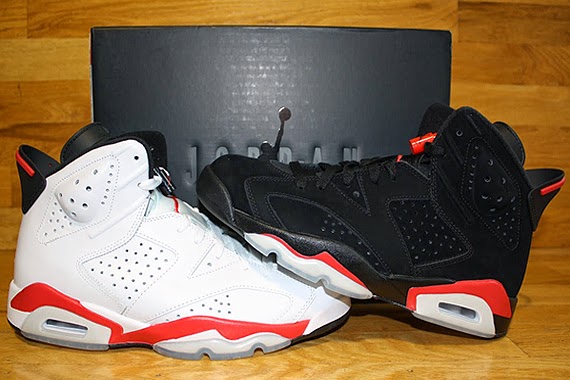
The Air Jordan VI is one of the most loved shoes in the Air Jordan line. Originally released in 1991, the White/September blue version was seen on the feet of Jerry Seinfeld in the second season of his hit TV series.
Tinker Hatfield designed the Air Jordan VI-inspired Batman boots worn by Michael Keaton in the 1992 film Batman Returns. On the court, Ray Allen and Vin Baker wore White/Navy/Red editions of the Air Jordan VI at the 2000 Sydney Olympic Games.
In 1991 while wearing the AJ VI, Michael averaged 31.5 points per game to win his fifth straight NBA scoring title. That year MJ was voted first team All-NBA, first team All-Defense and notched his seventh straight All-Star appearance while being named the 1991 league MVP. Most importantly Michael Jordan's skills and dedication culminated in the Bulls' first NBA Championship and was Jordan was named NBA Finals MVP.
Sunday, April 6, 2014
Air Jordan 5
In 1990, Designer Tinker Hatfield continued to push the envelope with the Air Jordan line. His creativity and innovative thinking continued on several levels with the design of the Air Jordan V. The shoe featured an asymmetrical collar and the cut of the shoe was higher than the previous two Air Jordans. The V still had the sculpted midsole, but included a new pattern inspired by a World War II fighter plane.
The visible air unit carried over from the III and IV, as did the use of mesh from the AJ IV. The outsole of the V was made of translucent rubber while very thin, clear rubber adorned the side panel of the upper and the lower part of the tongue.
Certain colorways of the AJ V used reflective 3M material on the tongue - a nice innovation to the Jordan line. On every Jordan V, an "AIR JORDAN" patch was stitched on the inside of the tongue.
Another first was the Grape Purple /Emerald colorway that had never been seen on a basketball shoe.
The heel of the AJ V was built with strong ankle support. The heel featured a stitched "NIKE AIR" logo with a Swoosh underneath. Lace locks were included with the Air Jordan V for added lockdown.
The V continued the great success of the Air Jordan line and came at a good time as Michael Jordan was hitting his stride in the NBA.
Jordan Brand has re-released the Air Jordan V in multiple colorways, including the original Grape, Fire Red and Black/Silver colorways as well as the White/Royal/Maze color inspired by Jordan's high school alma mater, Laney High.
While rocking the Air Jordan V in 1990, Michael Jordan made his sixth straight All-Star game appearance, won his fourth straight league scoring title and was named to the All-NBA First Team and All-Defensive First Team. Although the Bulls lost to the Pistons in the 1990 Conference Finals, Jordan was on the verge of one of the NBA's greatest dynasties - and driving the footwear industry to new heights.
The visible air unit carried over from the III and IV, as did the use of mesh from the AJ IV. The outsole of the V was made of translucent rubber while very thin, clear rubber adorned the side panel of the upper and the lower part of the tongue.
Certain colorways of the AJ V used reflective 3M material on the tongue - a nice innovation to the Jordan line. On every Jordan V, an "AIR JORDAN" patch was stitched on the inside of the tongue.
Another first was the Grape Purple /Emerald colorway that had never been seen on a basketball shoe.
The heel of the AJ V was built with strong ankle support. The heel featured a stitched "NIKE AIR" logo with a Swoosh underneath. Lace locks were included with the Air Jordan V for added lockdown.
The V continued the great success of the Air Jordan line and came at a good time as Michael Jordan was hitting his stride in the NBA.
Jordan Brand has re-released the Air Jordan V in multiple colorways, including the original Grape, Fire Red and Black/Silver colorways as well as the White/Royal/Maze color inspired by Jordan's high school alma mater, Laney High.
While rocking the Air Jordan V in 1990, Michael Jordan made his sixth straight All-Star game appearance, won his fourth straight league scoring title and was named to the All-NBA First Team and All-Defensive First Team. Although the Bulls lost to the Pistons in the 1990 Conference Finals, Jordan was on the verge of one of the NBA's greatest dynasties - and driving the footwear industry to new heights.
Air Jordan 4
Following the success of the III, Tinker Hatfield delivered one of the most comfortable, most-loved Air Jordans in the series, the Air Jordan IV.
The Jumpman logo made its second appearance on the tongue but with the word "Flight" added below it.
Like the sculpted midsole, the cut of the shoe was the same as the Air Jordan III. The visible Air unit and padded tongue and collar also carried over from the AJIII.
The nubuck material was introduced to the sneaker world on the upper of the Air Jordan IV. The AJ IV featured mesh for the first time, increasing breathability. Multiple areas of the IV featured plastic. Attached to the nubuck heel was a lean triangular plastic piece that was connected to a hard plastic lace holder. The lace holder at the forefoot provided added lockdown.
The heel tab that read "Nike Air" was plastic and similar to that of the Air Jordan III. Also on the upper was a plastic grid pattern that lay over the breathable mesh and behind the triangular piece.
To market the shoe, a new batch of Michael Jordan/Mars Blackmon commercials aired.
The Air Jordan IV is one of the most collected shoes in the series. Ten years after its original release, Nike retroed the AJ IV in 1999; it sold out immediately.
Wearing Air Jordan IV, MJ was voted to his fifth consecutive All-Star game and won the league scoring title for the third consecutive year. One of the most memorable Air Jordan IV moments was when Michael hit the series-clinching, hanging jumper over Craig Ehlo in the first round of the playoffs against Cleveland - better known as "The Shot."
The Jumpman logo made its second appearance on the tongue but with the word "Flight" added below it.
Like the sculpted midsole, the cut of the shoe was the same as the Air Jordan III. The visible Air unit and padded tongue and collar also carried over from the AJIII.
The nubuck material was introduced to the sneaker world on the upper of the Air Jordan IV. The AJ IV featured mesh for the first time, increasing breathability. Multiple areas of the IV featured plastic. Attached to the nubuck heel was a lean triangular plastic piece that was connected to a hard plastic lace holder. The lace holder at the forefoot provided added lockdown.
The heel tab that read "Nike Air" was plastic and similar to that of the Air Jordan III. Also on the upper was a plastic grid pattern that lay over the breathable mesh and behind the triangular piece.
To market the shoe, a new batch of Michael Jordan/Mars Blackmon commercials aired.
The Air Jordan IV is one of the most collected shoes in the series. Ten years after its original release, Nike retroed the AJ IV in 1999; it sold out immediately.
Wearing Air Jordan IV, MJ was voted to his fifth consecutive All-Star game and won the league scoring title for the third consecutive year. One of the most memorable Air Jordan IV moments was when Michael hit the series-clinching, hanging jumper over Craig Ehlo in the first round of the playoffs against Cleveland - better known as "The Shot."
Air Jordan 3
With buzz surrounding Michael Jordan and his signature kicks, Nike looked to corporate architect-turned-footwear-designer Tinker Hatfield to head up the creation of the Air Jordan III.
Hatfield's design of the Air Jordan III was unique in several aspects: - The Air Jordan "wings" logo was no longer present - it was replaced by the newly introduced Jumpman logo on the tongue.
The cut of the shoe was a mid, which had never been seen in the basketball shoe world before. The midsole was crafted with highly sculpted polyurethane, which introduced a fresh look. The visible Air unit was introduced to the Air Jordan line, allowing players to literally "walk on air."
Possibly the most distinct aspect of the Air Jordan III was the upgrade in materials. The upper was constructed of rich full-grain tumbled leather and was built to feel broken in - Jordan could wear a brand new pair every game without worrying about stiffness in the shoes.
Hatfield also chose to combine the tumbled leather with faux elephant skin. The elephant print was featured on the toe cap and heel of the kicks. (It also showed up on the bottom of the shoe box.)
The Air Jordan III continued the progression of the footwear industry. Its materials, technology and fresh design - with the assistance of a revolutionary Air Jordan commercial - took the basketball world by storm. Nike linked up with writer/actor/director Spike Lee for a spot starring Michael Jordan and Spike's character Mars Blackmon. MJ and Mars collaborated on several more Air Jordan commercials in the coming years.
Michael averaged 35 points per game on his way to being voted to his fourth straight All-Star game where he won the MVP award and second straight Slam Dunk title. He was also voted the Defensive Player of the Year, won the league scoring title and took home the league MVP trophy - all while wearing the Air Jordan III.
The AJ III is one of the most popular, in-demand Air Jordans in the series and continues to sell out every re-release.
Subscribe to:
Comments (Atom)




.jpg)



















